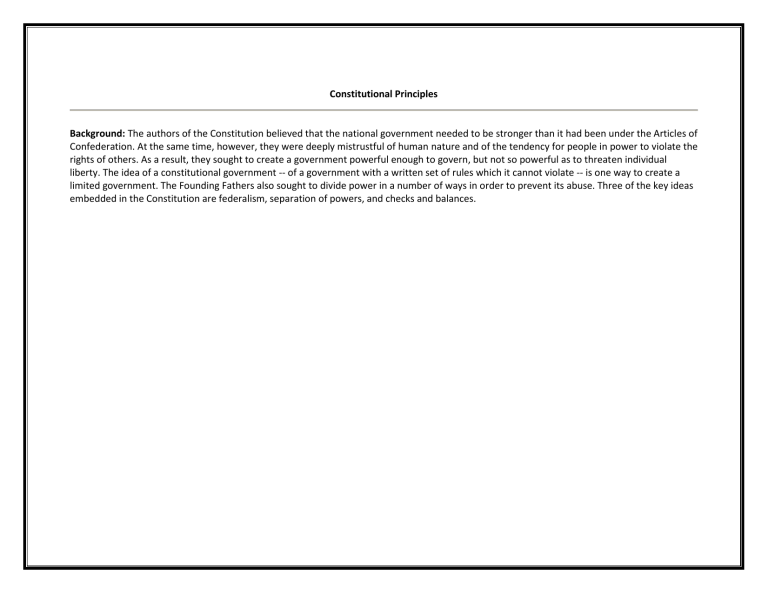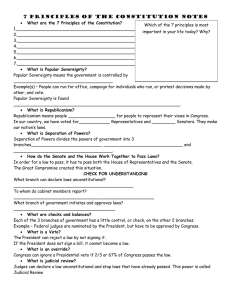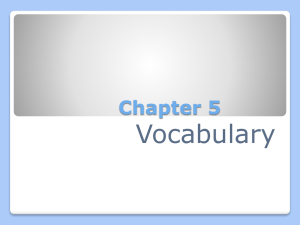Constitutional Principles Worksheet - fchs

Constitutional Principles
Background: The authors of the Constitution believed that the national government needed to be stronger than it had been under the Articles of
Confederation. At the same time, however, they were deeply mistrustful of human nature and of the tendency for people in power to violate the rights of others. As a result, they sought to create a government powerful enough to govern, but not so powerful as to threaten individual liberty. The idea of a constitutional government -- of a government with a written set of rules which it cannot violate -- is one way to create a limited government. The Founding Fathers also sought to divide power in a number of ways in order to prevent its abuse. Three of the key ideas embedded in the Constitution are federalism, separation of powers, and checks and balances.
Federalism
In a federal system, power is divided between a national government and the state governments. The sovereignty of the national government is established by the Supremacy Clause, but states retain the right to rule in certain areas. Key elements of the federal system include:
National government and states retain sole power to govern in certain areas (see chart below)
Certain powers are denied to the national government
National and state governments share certain powers
The Supremacy Clause of the Constitution (Article VI) establishes that the Constitution and federal laws take precedence over state laws
The "equal protection" clause of the 14th Amendment requires that state laws must also conform to the guarantees in the Bill of Rights
National Powers
(Delegated Powers)
Regulate interstate and foreign commerce
Create and maintain armed forces
Print money
Declare war
Regulate immigration and naturalization
Establish foreign policy
Establish a post office
Powers Denied the
National Government
Pass Bills of
Attainder
Pass Ex Post Facto
laws
Suspend the Writ of
Habeas Corpus
Grant titles of
Nobility
Tax Exports
Favor one state over another
Shared Powers
(Concurrent Powers)
Borrow Money
Levy and collect
taxes
Make and enforce
laws
Charter Bank
State Powers
(Reserved Powers)
Regulate intrastate commerce
Establish and maintain schools
Establish and regulate laws for professional licenses and marriage
Create corporation laws
Establish local governments
Separation of Powers
The Constitution separates the powers granted to the national government into three separate branches: the legislative, the executive, and the judicial. This separation of powers was based on the ideas of the French philosopher Montesquieu. By dividing the power to govern among three branches, the authors of the Constitution hoped to provide a check against tyrannical rue.
Branch
Legislative Branch
(Congress)
Executive Branch
(Presidency)
Judicial Branch (Federal
Courts)
Primary
Responsibility
To Make the Laws
Powers
Regulate interstate and foreign commerce
Create and maintain armed forces
Print money
Declare war
Regulate immigration and naturalization
Establish a post office
Establish and maintain the federal court system
To Enforce the
Laws
To Interpret the
Laws
Execute federal laws and programs
Conduct foreign policy
Command the Armed Forces
Negotiate treaties
Nominate federal judges and ambassadors
Rule on cases involving the violation of federal law, the Constitution, treaties, and/or maritime law
Rule on cases in involving federal officials, states suing other states, or representatives of
foreign governments
Rule on the Constitutionality of laws and Executive Orders
Checks and Balances
The separation of powers provided for in the Constitution is not absolute. Instead, the powers of the individual branches were designed to overlap in several key areas. This allows each branch of government to "check," or limit the power of, the other branches. The authors of the
Constitution hoped that this system of checks and balances would prevent any one branch of government from becoming too powerful.
Congress Checks President by:
Congress Checks Courts by:
President Checks Congress by:
President Checks Courts by:
Courts Check Congress by:
Courts Check President by:
Impeaching and Removing President (Impeachment requires a majority vote of the House; Removal requires a 2/3 majority of the Senate)
Overriding a Presidential Veto (requires a 2/3 majority of both Houses)
Rejecting Presidential nominations ( The Senate)
Rejecting Treaties (The Senate)
Proposing Constitutional Amendments
Creating lower courts
Impeaching and removing judges (Impeachment requires a majority vote of
the House; Removal requires a 2/3 majority of the Senate)
Rejecting Presidential nominations to the Courts (The Senate)
Vetoing legislation
Calling special sessions
Proposing legislation
Nominating federal judges
Granting pardons
Declaring laws unconstitutional
Declaring executive orders unconstitutional








